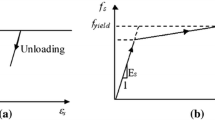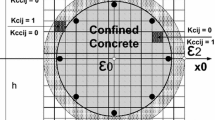Abstract
A new nonlinear analytical solution of the behavior of a slender reinforced concrete (RC) element under axial tension (known as “the tension stiffening problem”) is developed. It refers to a concrete slender element with a central steel reinforcing bar (rebar) that is bonded to the concrete. The rebar’s ends are loaded by tensile loads. An arbitrary nonlinear bond stress–slip relationship is considered, representing the nonlinear shear stress transmission at the rebar–concrete interface. The nonlinear solution is capable at solving the tension stiffening problem for any slip range. The solution provides the important parameters of the problem (e.g., slip at the RC element ends, rebar elongation, tensile stresses in concrete and rebar at the element center prior to cracking, and the cracking load levels). The first integral of the governing second-order nonlinear autonomous differential equation, accounting for the concrete–rebar interfacial slip, is derived, and using the boundary conditions, the slip at the RC element ends is obtained. Using the calculated slip, the other parameters are calculated. This solution procedure reduces the solution of a symmetric tension stiffening problem to sub-problems for uncracked sub-elements until a new crack is formed, after which the number of sub-elements doubles with half-length of each sub-element prior to crack formation. Since all sub-elements are identical, solution of a single sub-element is applied for all other sub-elements. The nonlinear solution is compared with experimental data and with approximate linear and bilinear solutions.



















Similar content being viewed by others
Data availability
All data, models, and code generated or used during the study appear in the submitted article.
References
Yankelevsky DZ, Jabareen M, Abutbul AD (2008) One-dimensional analysis of tension stiffening in reinforced concrete with discrete cracks. Eng Struct 30:206–217
Yankelevsky DZ, Karinski YS, Feldgun VR (2022) Analytical modeling of crack widths and cracking loads in structural RC members. Infrastructures 7(40):1–20
Karinski YS, Yankelevsky DZ, Feldgun VR (2022) Bi-linear bond–slip modelling for 1-D Tension stiffening of a RC element. Infrastructures 7(125):1–23
Leibovich O, Dancygier AN, Yankelevsky DZ (2016) An innovative experimental procedure to study local rebar–concrete bond by direct observations and measurements. Exp Mech 56:673–682
Leibovich O, Yankelevsky DZ, Dancygier AN (2019) Role of internal damage mechanisms in controlling bond–slip behavior in pullout tests in concrete. J Mater Civ Eng ASCE 31(12):1–14
Leibovich O, Yankelevsky DZ (2020) Nonlinear features of the bond–slip ascending branch. J Mater Civ Eng ASCE 32(10):1–15
Viwahtanatepa S, Popov EP, Bertero VV (1979) Effect of generalized loading on bond of reinforcing bar embedded in confined concrete. UCB/EERC-79/22. Earthquake Engineering Research Centre, University of California, Berkeley
Lee H, Choi E, Cho S-C, Park T (2012) Bond and splitting behaviour of reinforced concrete confined by steel jackets without grouting. Mag Concr Res 64(3):225–237
Harajli MH, Hamad BS, Rteil AA (2004) Effect of confinement on bond strength between steel bars and concrete. ACI Struct J 101(5):595–603
Tang C-W (2017) Uniaxial bond stress–slip behavior of reinforcing bars embedded in light weight aggregate concrete. Struct Eng Mech 62(5):651–661
Carvalho EP, Miranda MP, Fernandes DSG, Alves GV (2018) Comparison of test methodologies to evaluate steel–concrete bond strength of thin reinforcing bar. Constr Build Mater 183:243–252
Zhou L, Zheng Y, Li H, Song G (2020) Identification of bond behavior between FRP/steel bars and self-compacting concrete using piezoceramic transducers based on wavelet energy analysis. Arch Civ Mech Eng 20(37):1–16
Pedziwiatr J (2008) Influence of internal cracks on bond in cracked concrete structures. Arch Civ Mech Eng 8(3):91–105
Ernst & Sohn (2013) Fib Model Code for concrete structures (2010). Ernst & Sohn, Berlin
Yankelevsky DZ, Jabareen M (2002) 2-D aspects in modeling of tension stiffening in reinforced concrete. In: Proceedings of the 3rd international symposium on bond in concrete, Budapest, 2002
Yankelevsky DZ (1984) New finite element for bond–slip analysis. J Struct Eng Div ASCE 11(7):1533–1542
Yankelevsky DZ (1985) Analytical model for bond–slip behavior under monotonic loading. Build Environ 20(3):163–168
Yankelevsky DZ (1994) A two-phase one-dimensional model for steel concrete interaction. Comput Struct 65(6):781–794
Chan HC, Cheung YK, Huang YP (1992) Crack analysis of reinforced concrete tension members. J Struct Eng ASCE 118(8):2118–2132
Gupta AK, Maestrini SR (1990) Tension-stiffness model for reinforced-concrete bars. J Struct Eng ASCE 116(3):769–790
Biscaia HC, Chastre C, Silva MAG (2013) Linear and nonlinear analysis of bond–slip models for interfaces between FRP composites and concrete. Composites B 45:1554–1568
Vecchio FJ, Collins P (1986) The modified compression field theory for reinforced concrete elements subjected to shear. ACI J March–April:219–231
Collins MP, Mitchell D (1991) Prestressed concrete structures. Prentice Hall, Hoboken
Vecchio FJ (1989) Nonlinear finite element analysis of reinforced concrete membranes. ACI J January–February:26–35
Marti P, Alvarez M, Kaufmann W, Sigrist V (1998) Tension chord model for structural concrete. Struct Eng Int 8(4):287–298
Wu Z, Yuan H, Niu H (2002) Stress transfer and fracture propagation in different kinds of adhesive joints. J Eng Mech ASCE 128(5):566–573
Teng JG, Yuan H, Chen JF (2006) FRP-to-concrete interfaces between two adjacent cracks: theoretical model for debonding failure. Int J Solids Struct 43:5750–5778
Chen JF, Yuan H, Teng JG (2007) Debonding failure along a softening FRP-to-concrete interface between two adjacent cracks in concrete members. Eng Struct 29:259–270
Foccaci F, Nanni A, Bakis CE (2000) Local bond–slip relationship for FRP reinforcement in concrete. J Compos Constr ASCE 4(1):24–31
Potapov S, Masurel A, Marin P, Daudeville L (2017) Mixed DEM/FEM modeling of advanced damage in reinforced concrete structures. J Eng Mech 143(2):04016110, 1–13
Potapov S, Masurel A, Daudeville L, Marin P (2016) Using a mixed DEM/FEM approach to model advanced damage of reinforced concrete under impact. Int J Comput Methods Exp Meas 4(3):258–268
Muñoz BM (2010) Study of bond behaviour between FRP reinforcement and concrete. PhD Thesis, University of Girona
Cox JV, Cochran KB (2003) Bond between carbon fiber reinforced polymer bars and concrete. II: computational modeling. J Compos Constr ASCE 7(2):164–171
Lin H, Zhao Y, Ozbolt J, Feng P, Jiang C, Eligehausen R (2019) Analytical model for the bond stress–slip relationship of deformed bars in normal strength concrete. Constr Build Mater 198:570–586
Murcia-Delso J, Shing PB (2015) Bond–slip model for detailed finite-element analysis of reinforced concrete structures. J Struct Eng 141(4):04014125
Miranda MP, Morsch IB, De Brisotto D, Bittencourt E, Carvalho EP (2021) Steel–concrete bond behavior: an experimental and numerical study. Constr Build Mater 271:121918
Santos J, Henriques AA (2015) New finite element to model bond–slip with steel strain effect for the analysis of reinforced concrete structures. Eng Struct 86:72–83
Popovics S (1973) A numerical approach to the complete concrete stress–strain relation for concrete. Cem Concr Res 3(5):583–599
Carrara P, Ferretti D (2013) A finite-difference model with mixed interface laws for shear tests of FRP plates bonded to concrete. Composites B 54:329–342
Phan TS, Rossi P, Tailhan J-L (2015) Numerical modelling of the concrete/rebar bond. Cem Concr Compos 59:1–9
Noh S-Y (2009) Tension stiffening model for numerical analysis of RC structures by using bond–slip relationship. J Adv Concr Technol 7(1):61–78
Wu Y-F, Xu X-S, Sun J-B, Jiang C (2012) Analytical solution for the bond strength of externally bonded reinforcement. Compos Struct 94:3232–3239
Dai J, Ueda T, Sato Y (2006) Unified analytical approaches for determining shear bond characteristic of FRP–Concrete Interfaces through pullout tests. J Adv Concr Technol 4(1):133–145
Noakowski P (1978) Die Bewehrung von Stahlbetonbauteilen bei Zwangsbeanspruchung infolge Temperatur. Deutscher Ausschuss für Stahlbeton 296
Boyce WE, DiPrima RC (2012) Elementary differential equations and boundary problems. Wiley, Hoboken
Rizkalla SH, Hwang LS, El Shahawi M (1983) Transverse reinforcement effect on cracking behaviour of R.C. members. Can J Civ Eng 10(4):566–581
Acknowledgements
This work was supported by a Joint Grant from the Centre for Absorption in Science of the Ministry of Immigrant Absorption and the Committee for Planning and Budgeting of the Council for Higher Education under the framework of the KAMEA Program.
Note: This grant has no number.
Author information
Authors and Affiliations
Contributions
Conceptualization - D. Yankelevsky; Methodology - V. Feldgun and D. Yankelevsky; Validation, formal analysis and investigation - V. Feldgun, D. Yankelevsky and Y. Karinski; Original draft preparation - V. Feldgun, D. Yankelevsky. Review & editing - V. Feldgun, D. Yankelevsky and Y. Karinski.
Corresponding authors
Ethics declarations
Competing interests
The authors declare no competing interests.
Conflict of interest
There is no conflict of interest.
Ethical approval
This article does not contain any studies with human participants or animals performed by any of the authors.
Additional information
Publisher's Note
Springer Nature remains neutral with regard to jurisdictional claims in published maps and institutional affiliations.
Rights and permissions
Springer Nature or its licensor (e.g. a society or other partner) holds exclusive rights to this article under a publishing agreement with the author(s) or other rightsholder(s); author self-archiving of the accepted manuscript version of this article is solely governed by the terms of such publishing agreement and applicable law.
About this article
Cite this article
Feldgun, V.R., Yankelevsky, D.Z. & Karinski, Y.S. Nonlinear analytical solution of a slender reinforced concrete element under axial tension. J Eng Math 140, 8 (2023). https://doi.org/10.1007/s10665-023-10270-x
Received:
Accepted:
Published:
DOI: https://doi.org/10.1007/s10665-023-10270-x




